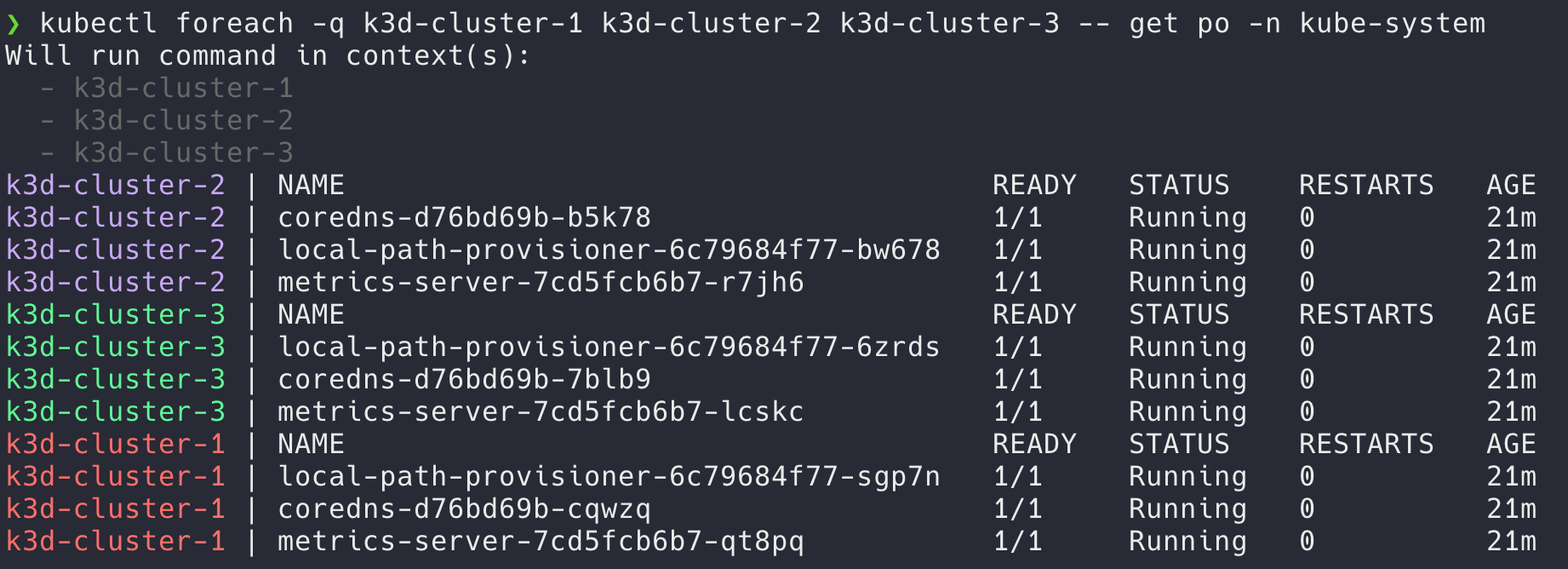
kubectl foreach 在多个集群中执行 kubectl 命令
上周在写 K8s 多集群的流量调度 的 demo 部分时需要不停地在多个集群中安装组件、部署应用,或者执行各种命令。当时是通过 Linux shell 脚本并通过工具 kubectx 进行集群的切换,像这样:

或者这样:

操作繁琐,很是痛苦。
今天偶然间发现了一个 kubectl 插件 kubectl foreach ,可以在多个集群(contexts)上执行 kubectl 命令。比如 kubectl foreach cluster-1 cluster-2 -- get po -n kube-system 。
插件安装和使用很简单,通过 krew 进行安装:
kubectl krew install foreach
使用也很简单:
kubectl foreach -h
Usage:
kubectl foreach [OPTIONS] [PATTERN]... -- [KUBECTL_ARGS...]
Patterns can be used to match context names from kubeconfig:
(empty): matches all contexts
NAME: matches context with exact name
/PATTERN/: matches context with regular expression
^NAME: remove context with exact name from the matched results
^/PATTERN/: remove contexts matching the regular expression from the results
Options:
-c=NUM Limit parallel executions (default: 0, unlimited)
-I=VAL Replace VAL occurring in KUBECTL_ARGS with context name
-q Disable and accept confirmation prompts ($KUBECTL_FOREACH_DISABLE_PROMPTS)
-h/--help Print help
Examples:
# get nodes on contexts named a b c
kubectl foreach a b c -- get nodes
# get nodes on all contexts named c0..9 except c1 (note the escaping)
kubectl foreach '/^c[0-9]/' ^c1 -- get nodes
# get nodes on all contexts that has "prod" but not "foo"
kubectl foreach /prod/ ^/foo/ -- get nodes
# use 'kubectl tail' plugin to follow logs of pods in contexts named *test*
kubectl foreach -I _ /test/ -- tail --context=_ -l app=foo
接下来测试下,使用 k3d 创建 3 个集群 (k3d 貌似不支持同时创建多个集群,还是需要 for 脚本来操作):
for CLUSTER_NAME in cluster-1 cluster-2 cluster-3
do
k3d cluster create ${CLUSTER_NAME} \
--image docker.io/rancher/k3s:v1.23.8-k3s2 \
--servers-memory 4g \
--k3s-arg "--disable=traefik@server:0" \
--no-lb \
--timeout 120s \
--wait
done
集群安装完成:
k3d cluster list
NAME SERVERS AGENTS LOADBALANCER
cluster-1 1/1 0/0 false
cluster-2 1/1 0/0 false
cluster-3 1/1 0/0 false
注意,k3d 安装的集群的 context 都带有前缀 k3d- ,在使用 kubectl foreach 的时候要注意:
kubectx
k3d-cluster-1
k3d-cluster-2
k3d-cluster-3
比如查看各个集群中的 kube-sysmte 下的 pod:
kubectl foreach -q k3d-cluster-1 k3d-cluster-2 k3d-cluster-3 -- get po -n kube-system

或者试试创建 deployment,这次我们不列出完整的 context name,而是使用正则 /cluster/:
kubectl foreach -q /cluster/ -- create deploy pipy --image flomesh/pipy -n default
Will run command in context(s):
- k3d-cluster-1
- k3d-cluster-2
- k3d-cluster-3
k3d-cluster-1 | deployment.apps/pipy created
k3d-cluster-3 | deployment.apps/pipy created
k3d-cluster-2 | deployment.apps/pipy created
然后查看下 pod:
kubectl foreach -q /cluster/ -- get pod -n default
Will run command in context(s):
- k3d-cluster-1
- k3d-cluster-2
- k3d-cluster-3
k3d-cluster-1 | NAME READY STATUS RESTARTS AGE
k3d-cluster-1 | pipy-df659b55f-bnr27 1/1 Running 0 25s
k3d-cluster-3 | NAME READY STATUS RESTARTS AGE
k3d-cluster-3 | pipy-df659b55f-p9j49 1/1 Running 0 25s
k3d-cluster-2 | NAME READY STATUS RESTARTS AGE
k3d-cluster-2 | pipy-df659b55f-9bjgf 1/1 Running 0 25s
查看日志
kubectl foreach -q /cluster/ -- logs -l app=pipy -n default --tail 3
Will run command in context(s):
- k3d-cluster-1
- k3d-cluster-2
- k3d-cluster-3
k3d-cluster-2 | 2022-11-30 10:40:56.520 [INF] [listener] Listening on TCP port 8080 at 0.0.0.0
k3d-cluster-2 | 2022-11-30 10:40:56.520 [INF] [listener] Listening on TCP port 8081 at 0.0.0.0
k3d-cluster-2 | 2022-11-30 10:40:56.520 [INF] [listener] Listening on TCP port 8082 at 0.0.0.0
k3d-cluster-1 | 2022-11-30 10:40:56.551 [INF] [listener] Listening on TCP port 8080 at 0.0.0.0
k3d-cluster-1 | 2022-11-30 10:40:56.551 [INF] [listener] Listening on TCP port 8081 at 0.0.0.0
k3d-cluster-1 | 2022-11-30 10:40:56.551 [INF] [listener] Listening on TCP port 8082 at 0.0.0.0
k3d-cluster-3 | 2022-11-30 10:40:55.813 [INF] [listener] Listening on TCP port 8080 at 0.0.0.0
k3d-cluster-3 | 2022-11-30 10:40:55.813 [INF] [listener] Listening on TCP port 8081 at 0.0.0.0
k3d-cluster-3 | 2022-11-30 10:40:55.813 [INF] [listener] Listening on TCP port 8082 at 0.0.0.0
注意,多集群的操作要谨慎,尤其是使用正则来匹配 context name;还有 -q 参数会跳过要操作的集群提醒,直接执行命令。



